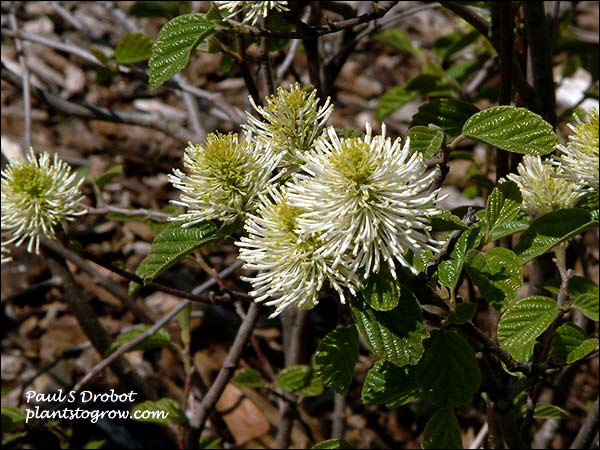| Description | Dwarf Fothergilla (Fothergilla gardenia) is a smaller shrub that blooms in early spring with fragrant bottlebrush flowers. |
|---|---|
| Pronunciation | (faw-thur-GIL-luh)(gaar-DEE-nee-eye) |
| Plant Type | Shrubs Deciduous |
| Hardiness Zone | 5-8 |
| Sunlight | full to part sun |
| Moisture | average to moist |
| Soil & Site | average, loamy, high organic matter |
| Flowers | Flowers are white, apetalous, honey scented, appear before leaves, and look like bottle brushes. Attracts bees and other pollinators. |
| Fruit | Fruit is an ornamentally insignificant, two-seeded, beaked capsule that matures in fall (September to October), ejecting its black seeds. |
| Leaves | Simple, blue-green, leathery leaves with yellow, orange, or red fall colors. |
| Dimensions | 2-3 feet tall by 4-5 foot spread, suckers forming colonies |
| Propagation | stem cuttings |
| Native Site | They are native to the coastal plains of the southern United States. In the wild, it is apt to grow in wet savannas, pocosins, baygalls, and bogs. |
| Misc Facts | Fothergilla is a prevernal plant that blooms very early in spring. "The shrub is named for John Fothergill, a British physician and botanist who died in 1780. The specific name honors Alexander Garden (1730-1791), a Scottish physician and plant enthusiast who lived in South Carolina and introduced the plant to England." (#270) |
| Notes & Reference | #01-Manual of Woody Landscape Plants (Michael Dirr), #226-Shrubs and Vines for American Gardens (Donald Wyman), #270-North Carolina Extension Gardener Tool Box (https://plants.ces.ncsu.edu/plants) |

Cart









